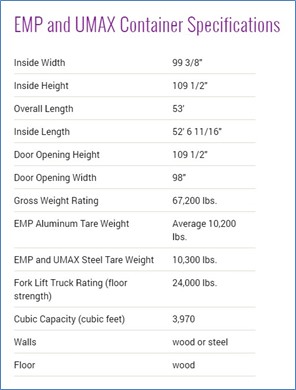
Intermodal Container Loading Procedures and Regulations
Article
It’s National Safety Month and here at Loup, we understand the importance of adhering to proper loading procedures to keep our customers, our employees and shipments safe. Let’s take a look at the regulations for intermodal shipments as determined by the Association of American Railroads (AAR) and the weight limits outlined by the United States Department of Transportation (DOT).

What Is Intermodal Shipping?
Thanks to our parent company, Union Pacific Railroad, we have access to the largest intermodal
network, most capacity and premium value-added solutions to meet your shipping needs. Plus, Union
Pacific has the largest dedicated container fleet for domestic customers with more than 80,000
containers offered through EMP and UMAX.
EMP is a domestic interline container service offer by Union Pacific and Norfolk Southern, and UMAX
is a domestic interline container service offered by UPRR and CSX Intermodal. Learn more about EMP
and UMAX
Three Steps for Damage-Free Shipments
Did you know 99.8% of all Union Pacific intermodal shipments arrive damage free? Follow these three simple steps to ensure your shipments arrive safely and damage free:
- Distribute the weight evenly across the container floor.
- Prevent side-to-side weight shifts using AAR-approved void fillers.
- Prevent front-to-back product movement using airbags or other AAR-approved void fillers.
Intermodal Shipment Weight Maximum
In total, the maximum gross weight allowed for a standard 53-foot domestic intermodal container is 80,000 pounds, including the tractor or truck, chassis and container weight itself.
- Steer axle must not exceed 12,000 pounds.
- Drive axle must not exceed 17,000 pounds per axle or 34,000 pounds in tandem.
- Container/trailer axle must not exceed 17,000 pounds per axle or 34,000 pounds in tandem.
Be aware that weight standards may vary by state, and California, specifically, has additional regulations.
Loup’s Intermodal Loading Tips
- Set a maximum weight of 42,500 pounds for intermodal shipments to avoid overweight containers. If the bill of lading weight is greater than 42,500 pounds, the container may require to be scaled at the origin shipping facility.
- Factor in the difference in weight between various shipping methods and equipment. Typically, a 53-foot domestic intermodal container and chassis weight is 3,000 to 4,000 pounds heavier than a standard aluminum over-the-road trailer. In addition, all loads must be within legal weight limits, even with a sleeper-berth tractor which can weigh up to 18,500 pounds.
- Use SAFE LOAD, Union Pacific’s resource guide for loading procedures. These methods will help you prevent derailment and freight damage.
Why Is Proper Loading So Important?
At Loup, we want to ensure the safety of our drivers, fleets and your shipments. The best way we can achieve this is by following the guidelines and regulations established by the railroad, AAR and DOT. These laws and procedures are important and help to ensure intermodal shipments are delivered safely and damage free.
Contact Us
Want to learn more about the economical, efficient door-to-door shipping solutions Loup can offer you? Contact us.
Contact Us
